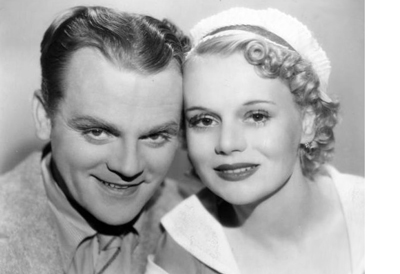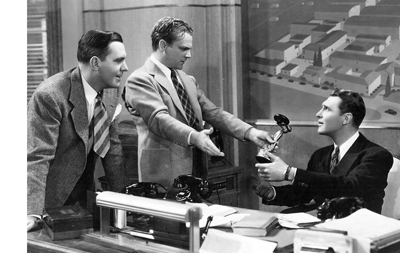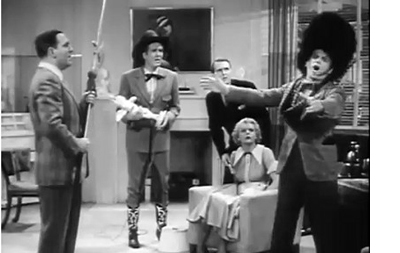
 |
|
|
|
When you look at the movie stars of Warner Bros., quite a few careers seem to have been short-changed. There's the top star Errol Flynn, who was capable of great things but stayed mostly in an action-adventure rut. Then there is the interesting Ann Dvorak, a lively favorite who ran afoul of management and all but disappeared from the screen. James Cagney has always been a special case -- in his 1930s WB pix he always seemed to work with the same small group of actors in a narrow range of roles. He had his own squabbles with the front office, mostly over money. With certain exceptions was forced to repeatedly play the same kind of character. It all ended with Cagney eventually leaving the studio, only to come back seven years later. 
1938's Boy Meets Girl is a definite attempt to do something different. A shrill screwball comedy, it pushes the pace too hard, with sequences in which the dialogue is too fast even for the screwball style. Cagney and co-star Pat O'Brien have no problem keeping up, having been experts in machine-gun patter in scores of pre-Code comedy and action films. The picture is clever and even daring, but it's also more than a little headache inducing. It's The Front Page in a movie studio, with more slapstick and less social comment. Daffy screenwriters Robert Law and J.C. Benson (Cagney & O'Brien) are either bored or contemptuous of their highly paid jobs at Royal Studios, because they spend their days avoiding work, pulling outrageous pranks and annoying C. Elliott "C.E." Friday (Ralph Bellamy), an executive who thinks trombones and trumpets are the same thing. Assigned to write a movie for the likeable but dimwitted cowboy star Larry Toms (Dick Foran), they do little but dish out insults. The dub themselves geniuses for reshuffling lame story elements: "Boy meets girl, boy loses girl, boy gets girl". Law and Benson find inspiration in daffy studio waitress Susie (Marie Wilson), who by a crazy turn of events is an unmarried expectant mother. Becoming the child's godparents, Robert and J.C. write a film that makes the baby (named 'Happy") into a national sensation, even though all it can do is sit and drool. Larry Toms objects to playing in movie after movie where Boy meets baby, boy loses baby, boy gets baby. Even C.E. thinks it's great until he finds that his screenwriters have Happy under exclusive contract. C.E. fires them and connives to get Happy back in the studio fold. He encourages Larry Toms to marry Susie, not knowing that she and bit player Rodney Bevan (Bruce Lester) have been soft on each other all along. Will our smart-aleck screenwriters regain their jobs and continue to give C.E. grief? Will Happy stay a major star? 
Boy Meets Girl wants to be an anarchic romp in a studio, with Cagney and O'Brien acting like giddy maniacs, or perhaps characters from a WB cartoon. Law and Benson breeze without warning into their boss's office to cause nothing but trouble -- they make fun of C.E. Friday to his face, tie up his telephones, order in food, spill and break things, the works. C.E. is a pompous faux-intellectual constantly toadying to "B.K.," another exec up the line. Their mainly keep C.E. flummoxed, so that they have to do as little as possible. Bella and Sam Spewak's script from their own stage play maintains the chaos the usual way, by jamming in more entrances, phone calls and interruptions. C.E. reviews wardrobe fittings for a costume picture, which is how the dimwitted Suzie meets the polite English extra Rodney. With his constant half-smile, big Dick Foran never looks particularly intelligent, while the good actor Ralph Bellamy is called on to yell and protest so much that we wish he'd go away -- he's not as likeable here as he is in screwball movies like The Awful Truth and His Girl Friday. Fans of the now rather obscure Marie Wilson will find Boy Meets Girl a delight. Sort of a thinking man's version of a burlesque 'dumb blonde', Wilson later became a big radio star in a show called "My Friend Irma", which was adapted to become the first Jerry Lewis & Dean Martin film. In Boy Meets Girl her forever clueless Susie is always responding with a whiney high voice that shows that she isn't following what's going on. But Susie has a heart of gold; one of the better scenes has her interviewed at a premiere, going on so long that radio announcer Ronald Reagan has to yank the microphone away. 
The fact that Susie has a child without a father is a fairly dicey proposition for 1938, and the story's main conflict is a struggle between the studio and the writers to decide who will profit from the baby. Although a certain interest is maintained in the kid's welfare, the satire remains superficial. C.E.'s treatment of Susie swings between rude cruelty and insincere praise, depending on her value to the studio. Law and Benson try to do the right thing but also regard Happy as a meal ticket. Even more cynical is Larry Toms' agent Rossetti, played by favorite WB stock actor Frank McHugh. He congratulates the screenwriters on their slick coup -- which he knows will soon lead to their being fired. Nobody gets away with diverting the flow of money from a studio. There's something slightly off in the comic capers of Cagney and O'Brien. As pointed out by DVDtalk reviewer Justin Remer, the show was once planned for the radio/film comics Olsen and Johnson, and more of an ensemble piece. The 'capers' are real in that Cagney is more likely to dance around a room rather than walk. He does pirouettes and tap dance steps to amuse himself, while O'Brien rattles off sidekick-like snappy banter 'in harmony' to Cagney's lead. But O'Brien seems too laid back and disengaged, and we don't understand exactly why Cagney should be exerting so much energy -- what worked back in Footlight Parade now seems too frantic by half. We're supposed to think that the crazy tomfoolery is an outlet for Law and Benson's frustrated creative energy. They crash the filming of a Berkeley-style musical, dancing with the chorus girls and making a complete nuisance of themselves. They harass C.E. by organizing the studio's Indians to protest below his window. The Indians are not studio extras playing along with the joke, but supposed 'real' Indians that chant "How" and "Ugh!" in response to Law's lefty agitation. This is the kind of comedy that uses a quartet of trumpeters as a running gag, prancing in at regular intervals to signal musical fanfares as punch lines. 
Director Lloyd Bacon keeps the camera wide, letting things play as if on a stage. Is the show just silliness, as in a Leon Schlesinger cartoon? On the surface the only message would seem to be that movie studios are overflowing with talentless talent and loony creative types. No matter how many dumb 'Boy meets girl' movies they make, the public flocks to see them. But shadows of other industry issues are present, if understated. The conflict between talent and management becomes real when the two screenwriters horn in on a piece of the action. In the 1930s the studio system allowed a few super-agents like Myron Selznick to control talent, but fifteen years later the agents would all but take over the business. Although there's no mention of the tyranny of one-sided contracts, the exploitation inherent in the system is addressed with little Happy, the star infant. Before he is born Happy is already 'owned' as if he were a promising racehorse. And Larry Toms may not be a great talent, but he's rightfully frustrated to be strait-jacketed into factory-system formula pictures that bog down worthy careers. And finally, there's the old writer's dilemma of deciding whether to be honest or keep taking the money. Robert Law knows that he'll have to go back East and start writing again, if his work is ever to get beyond Boy Meets Girl. James Cagney never regretted leaving Broadway - he said he'd rather be working on a farm - but he must have had grave misgivings every time he was asked to play the same old tough-guy roles. Boy Meets Girl only hints at those ideas. it's possible that the original play had more to say, but the screenplay opts for a maximum of joke lines. The fairy-tale solution for the Susie and Happy subplot could be evidence of a desire to avoid any real satirical content - or it could be merely a concession to the censors. Yet there's definitive proof that Boy Meets Girl is written by people with intimate knowledge of the film industry. At one point a character identified as a film editor (John Ridgeley) enters C.E.'s office. He's treated like an errand boy. That immutable reality has persisted to the present day.
The Warner Archive Collection DVD-R of Boy Meets Girl is a good rendering of this curious, very
The image and sound are par for mid-range WAC presentations. An original trailer is included.
On a scale of Excellent, Good, Fair, and Poor,
Boy Meets Girl DVD-R rates:

Reviews on the Savant main site have additional credits information and are often updated and annotated with reader input and graphics. T'was Ever Thus.
Review Staff | About DVD Talk | Newsletter Subscribe | Join DVD Talk Forum |
| ||||||||||||||||||